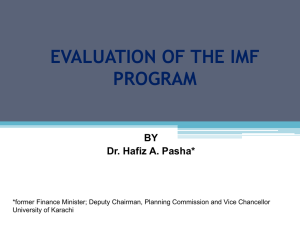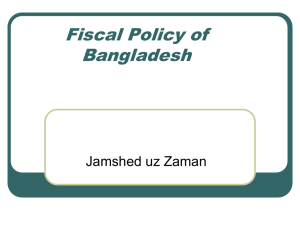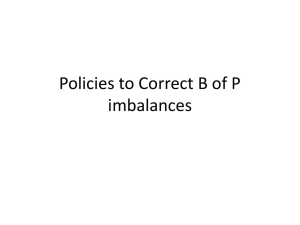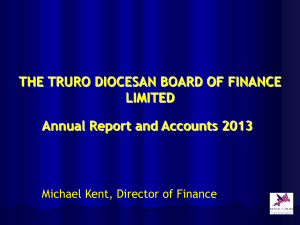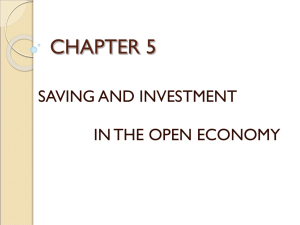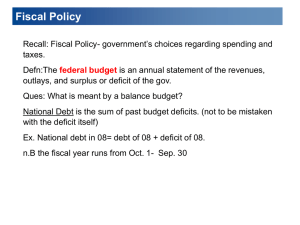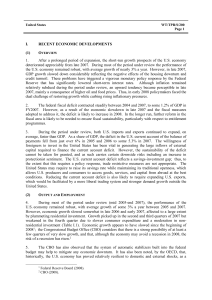Assessing of Economic Prospects in Paksitan 2011-12
advertisement
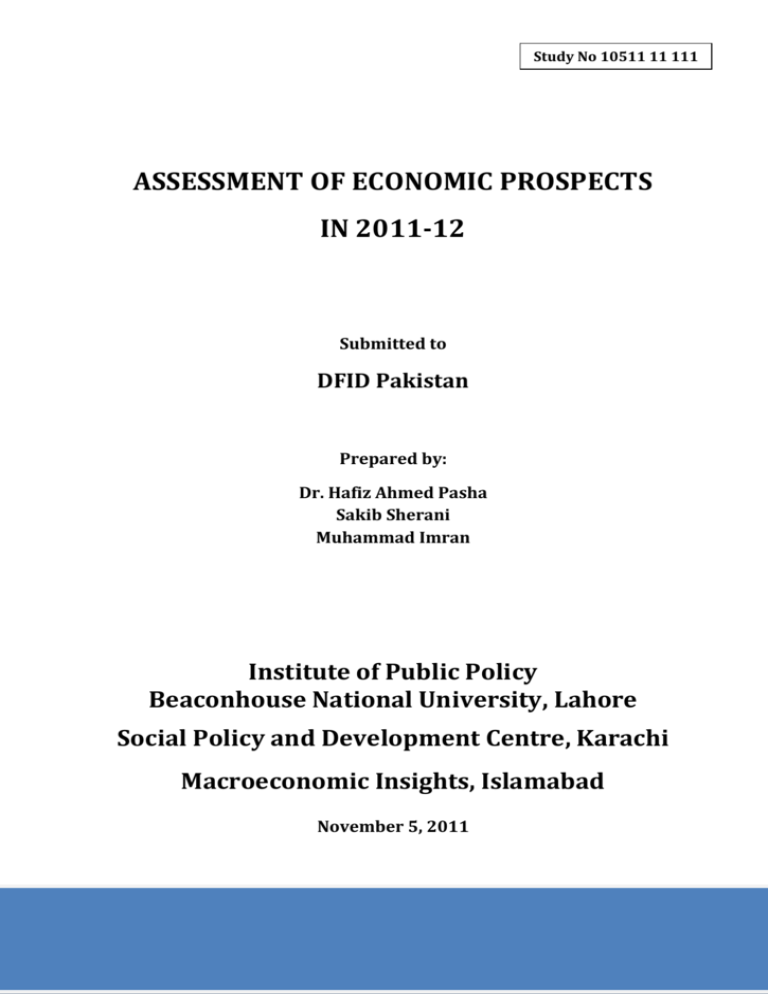
Study No 10511 11 111 ASSESSMENT OF ECONOMIC PROSPECTS IN 2011-12 Submitted to DFID Pakistan Prepared by: Dr. Hafiz Ahmed Pasha Sakib Sherani Muhammad Imran Institute of Public Policy Beaconhouse National University, Lahore Social Policy and Development Centre, Karachi Macroeconomic Insights, Islamabad November 5, 2011 1|Page SUMMARY The outlook for 2011-12 is a marginal improvement in GDP growth; more or less, unchanged rate of inflation and fiscal deficit; significant worsening of the balance of payments and fall in foreign exchange reserves. The important risk factors on the fiscal side include: shortfall in FBR revenues; lower than budgeted Coalition Support Fund (CSF) receipts; no receipt by Pakistan Telecommunication Authority (PTA); substantially higher expenditure on subsidies and high level of domestic borrowings. Risks on the balance of payments front include fall in prices of textile products; higher import bill due to oil, fertilizer and raw cotton imports; less program aid inflows due to end of IMF program; no privatization receipts and lower CSF inflows. The more or less unchanged inflationary scenario may alter if there are very high domestic borrowings and large exchange rate depreciation. Also, growth may be lower in relation to the Annual Plan target because of Sindh flood impact and fall in private investment. 1|Page ASSESSMENT OF ECONOMIC PROSPECTS IN 2011-121 The Annual Plan for 2011-12 envisages some recovery of the flood-ravaged economy with a GDP growth rate above 4 percent and progress in macroeconomic stabilization with the rate of inflation at 12 percent for the year, but down to 8.5 percent by June 2012. The Federal Budget for 2011-12 targets for a modest fiscal deficit of 4 percent of the GDP while pursuing economic revival by a cut in indirect tax rates2 on industry and a big jump in development expenditure of 72 percent. The deficit is to be contained through a cutback in subsidies, especially to the power sector, by Rs 234 billion, along with some broad-basing of the General Sales Tax (GST) on goods to cover agricultural inputs, machinery and domestic sales of export sectors.3 Soon after the start of the new financial year, there have been some negative developments, both global and local. First the debt-downgrade of US and a looming debtcrisis in Europe imply a weaker economic recovery globally, thereby affecting the prospects for Pakistani exports. Second, the floods in Sindh, two years running, have inflicted widespread damage. Over 6 million people have been affected. Standing kharif crops over 2.2 million acres of cotton, rice, sugarcane and vegetables have been damaged. Third, the actual fiscal outcome for 2010-114 has turned out to be worse than revealed by the revised estimates at the time of the framing of the budget. Revenues were Rs 91 billion lower and expenditure 77 billion higher, especially on power subsidies. This has made the task of achieving the 4 percent fiscal deficit target even more difficult. Simultaneously, the political temperature has heated up. The PML-N has taken on the role of a more aggressive opposition. Large rallies by political parties are taking place on the back of large-scale public protests, in particular, against the high level of power outages. The Government is in a reactive mode and engaged in fire fighting operations with subventions to the power sector, railway, etc. Senate elections are due in March 2012 and the next general elections in February 2013. Given the present composition of the Assemblies, PPP is expected to increase substantially its seats in the Senate. Therefore, agitation by the PML-N is seen as an effort at forcing early elections. Whether it succeeds or not, it is clear that the country is moving into an election mode. Consequently, it has become increasingly difficult for the government to implement reforms to improve the fiscal situation like a big hike in power tariffs, campaign against taxevasion, etc. On the contrary, there is likely to be a shift in the policy stance towards pump priming of the economy by the stimulation of aggregate demand prior to elections. The first indication of this is the sharp cut of 150 basis points in the policy rate of the Central Bank. Development expenditure is also likely to remain high with special allocations to mega projects, for schemes in key constituencies and largerfunds for BISP. Pakistan has also exited from the IMF SBA on the 30th of September on the grounds that foreign exchange reserves at $ 17.3 billion5 are adequate. Clearly, implementation of reforms to fulfil the IMF conditionalities has become more difficult in the prevailing political environment. Markets did react unfavourably initially in the last week of September and the rupee fell to below Rs 90 to the dollar in the open market, and recovered only after intervention by the SBP. This could be a precursor of things to come. The first four months of 2011-12 have seen some moderation in the headline rate of inflation to 11 percent.6But ‘core’ inflation continues to show a rising trend. Government borrowings for budgetary support, mostly from commercial banks, remain relatively high at 2|Page Rs 280 billion as of 22nd October, as compared to Rs 181 billion last year. Tax revenues have performed relatively well with growth of 22 percent, but the real challenge of achieving the target will come in the last three months of 2011-12.7 Inflows of external assistance have been limited8 and this is putting pressure on domestic borrowings. There have been worrying developments on the balance of payments front. The current account deficit has been recorded at $ 1.2 billion in the first three months, in relation to the official annual target deficit of $ 1.4 billion (see Table 1). In September alone the current account deficit was as high as $ 908 million. Exports and remittances continue to show some growth, but imports have risen by 24 percent during the quarter, with the increase in September of 42 percent. In particular, oil imports have risen by 55 percent. Reserves have fallen by $ 1.3 billion in the first four months. Overall, the likely economic prospects for 201112 are becoming visible. What then are the prospects for 2011-12? The IPP Macroeconomic Model has been used for forecasting the outcomes for the year, based on continuation of the coalition government up to the next elections, possibly in the second half of 2012, with deterioration in the reforms situation8. The IPP projections are compared with the official targets and recent projections by the IMF9respectively for Pakistan in Table 1. Fiscal Projections: As compared to the target fiscal deficit of 4 percent of the GDP the expected outcome is 6.8 percent of the GDP. The divergence is due particularly to, first, a shortfall of up to Rs 100 billion in achieving the FBR revenue target of Rs 1952 billion, second, a major shortfall in non-tax revenues due to uncertainty in flow of reimbursements from the Coalition Support Fund (CSF) of Rs 119 billion, third, non-realisation of revenues of Rs 75 billion by the Pakistan Telecommunications Authority and, fourth, possibly somewhat lower profits of the SBP, partly compensated for by lower interest payments on short-term domestic debt. Current expenditure is likely to be higher, first, because of the need to reduce the outstanding stock of ‘circular debt’ in the power sector and the inability to increase power tariffs sufficiently along with emergent larger losses in entities like PIA, Railway, Pakistan Steel Mill, etc. This could raise subsidies over the budgeted figure by over Rs 200 billion. Second, with higher international prices and larger fertilizer imports (due to gas shortage) the subsidy on imports could be higher by over Rs 50 billion. Third, the cost to the provincial governments9 of the 15 percent hike in salaries and 20 to 25 percent in pensions is about Rs 40 billion. Development expenditure is unlikely to be curtailed drastically due to the pressure of pre-election spending. The size of the estimated deficit in 2011-12 is Rs 1462 billion, almost Rs 600 billion higher than the official estimate. The outlook for net external assistance has turned negative following the end of the IMF program. Gross inflow of Rs 414 billion was budgeted. This includes Rs 118 billion of program loans, Rs 44 billion of Eurobonds10 and Rs 34 billion from the US as support under the Kerry-Lugar bill. In addition, receipts of Rs 70 billion from proceeds of privatization of PTCL are expected. All these inflows are uncertain now. External debt repayments of Rs 243 billion have to be made during the year. Therefore, an optimistic estimate of the net availability of external assistance for financing the budget deficit is about Rs 66 billion. This implies that domestic financing of Rs 1386 billion will have to be arranged, 28 percent above last year’s high level. This could exceed the appetite for government paper of commercial banks. Consequently, in the latter part of the financial year, 3|Page there is likely to be pressure on interest rates and significant borrowings from the Central Bank could become inevitable. Balance of Payments Projections: There is likely to be a qualitative transformation in the prospects for external balances, some of which has already become visible. The current account deficit is projected at $ 5.2 billion, as compared to the official forecast of $ 1.4 billion and IMF’s projection of $ 3.9 billion. Exports are expected to remain, more or less, at last year’s level due, first, to lack of buoyancy in global markets, second, a fall in prices of textile products from the peak attained in early 201111, third, constraints to production in exportoriented sectors due to power and gas shortages and, fourth, a reduced exportable surplus of rice due to the Sindh floods. In addition, exports of services could be lower because of smaller inflows from the CSF. Imports of goods are expected to show a growth of over 12 percent as, first, oil pricesare currently over 18 percent above the average last year and are unlikely to fall sharply in coming months12, second, edible oil prices remain relatively high, third, larger imports of fertilizer and, fourth, possibly higher raw cotton imports due to the loss of output in the Sindh floods. However, machinery imports are unlikely to be larger in the presence of a depressed environment for the private sector13. Remittances are expected to show a modest growth of 5 percent from the high level attained last year14. The outlook for foreign private investment (direct plus portfolio) remains negative with a drop of 5 percent. Net inflow of foreign assistance is projected at $ 700 million. In addition, debt repayment of $ 1.2 billion has to be made to the IMF. Overall, the deficit in the balance of payments in 2011-12 is likely to approach $ 4.2 billion, implying a corresponding fall in foreign exchange reserves from $ 14.8 billion at the end of 2010-11 to $ 10.6 billion by 30th June 2012. Such a decline in reserves is likely to put pressure on the exchange rate which could approach Rs 94 to the dollar in 2011-12. In the second half of 2012, conditions could deteriorate even further. GDP growth: As compared to the Annual Plan projection of GDP growth rate of 4.2 percent, the expectation is of a growth rate of 3.3 percent. This reflects, first, the impact of the Sindh floods. Second, private investment is likely to continue declining in real terms,third, the on-going efforts to stimulate the economy are likely to spill over more into inflation than higher output in the presence of severe supply-side constraints in the economy. Rate of Inflation: The rate of inflationis projected at close to 14 percent, similar to that by the IMF. This represents an upsurge from the present rate of 11 percent. Reasons for this are, first, the short-run impact of the loss of output in the Sindh floods on prices of food items, second, the faster depreciation in the value of the rupee could increase the component of imported inflation, especially in energy prices, and, third, increasing government borrowing in the latter part of the year could lead to faster growth in money supply, although this will be moderated by the decline in Net Foreign Assets (NFA), due to the fall in foreign exchange reserves. In conclusion, 2011-12 promises to be yet another difficult year, due to underlying political and economic developments. The phenomenon of stagflation will persist and external payments position will become increasingly vulnerable due to a weakening of both the current and financial accounts of the BOP. In effect, Pakistan is moving gradually but inexorably to a period of great financial difficulties. 4|Page Table 1 TARGETS AND PROJECTIONS FOR 2011-12 2011-12 Unit 2010-11 Actual Annual Plan Target IMF Economic Outlook Projections From IPP Model % 2.4 4.2 3.8 3.3 Agriculture % 0.6 3.4 - 1.8 Industry % -0.1 3.1 - 2.7 Services % 4.1 5.0 - 4.4 CPI % 13.9 12.0 14.0 13.7 Money Supply Growth % 15.9 16.2 18.3 13.0 Rate of Growth of Employment % 1.1 - - 1.4 Variable GDP Growth Rate Sectoral: Rate of Inflation FISCALa Total Revenues % of GDP 12.5 - 12.4 12.2 Tax Revenues = 9.4 - - 9.5 Non-Tax Revenues = 3.1 - - 2.7 = 19.1 - 18.0 19.1 Current Expenditure = 16.3 - - 16.1 Development Expenditure = 2.8 - - 3.0 = 6.6 4.0 5.3 6.8 %c 9.0 - - 4.8 Total Expenditure Fiscal Deficit Financing: External Domestic % 91.0 - - 95.2 % of GDP 57.6 - 57.3 58.7 Exportsd Growth % 29.3 5.6 -2.3f -0.9 Imports Growth % 14.5 6.0 6.5f 12.4 Remittances Growth % 25.8 0 - 5.0 $ Million +437 -1401 -3900 -5214 % -28.8 40.0 - -4.7 Net Aid Inflow $ million 357 1974 - 700 Net Balance of Payments $ million 2493 - -1883 -4213 $ million 14784 14986g 12900 10570 Rs/$ 85.5 85.0 - 94.1 Public Debt BALANCE OF PAYMENTS Current Account Surplus (+) Deficit (-) FDI Growth FE Reservese Exchange Rate for federal and provincial governments combined; b Including net lending; c Share in financing; d of goods (f.o.b) in US $ e inclusive of repayment to IMF of $ 1.2 billion; fGoods and Services; g net of CRR and SCRR a 5|Page FOOTNOTES Rather than assess the prospects upto April 2012, we extend the assessment for two more months, that is, up to June 2012, the last month of 2011-12. 2. The standard GST rate has been brought down from 17 percent to 16 percent, the special excise duty of 2.5 percent has been withdrawn; regulatory import duties have been removed and excise duty on cement has been cut. 3. The sales tax on machinery has since been withdrawn and domestic sales of export sectors are being taxed at a reduced rate of 6 percent. 4. Information on fiscal operations in 2010-11 was released by the Ministry of Finance only in late September 2011. 5. Excluding the amount held by commercial banks, reserves with SBP are $ 13.7 billion. 6. The new CPI, with base year of 2007-08, yields a somewhat lower rate of inflation year-on-year then the old CPI with base of 2000-01. 7. Tax revenues showed exceptionally high growth of 28 percent during April to June 2011 partly due to the hike in tax rates and withdrawal of exemptions from GST in the special flood package. Achieving a high growth rate of about 26 percent on this base will be difficult. 8. This corresponds to Scenario 1 in the report on Scenario Forecasting for Pakistan Economy, 2010-15 submitted in May 2011 by IPP to DFID. 9. The federal government has explicitly budgeted for the cost of the salary and pension increase of Rs 25 billion. 10. Unlikely given the state of capital markets in Europe. 11. The export prices (in $) of cotton yarn, cotton cloth and readymade garments have fallen by 27 percent, 10 percent and 4 percent respectively in July-September 2011, compared to March 2011. 12. Most projections, including that by the IMF and OPEC, indicate relative stability in oil prices in 2012 despite slower growth in the world economy due to relatively tight supply conditions generally and disruptions in countries like Libya. 13. Despite the recent fall in interest rates, private investment may not respond due to the uncertain political conditions and ‘crowding out’ from access to credit because of heavy government borrowing. 1. 14. Already in September 2011, home remittances are 32 percent lower in relation to the level attained in August 2011 and 3 percent below September 2010. 6|Page
